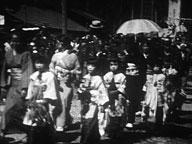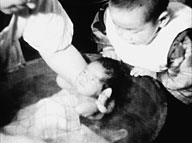Yamagata Household Cinema—A Look at Prewar Yamagata
To Gaze Across Time: Yamagata Home Movies
Watching films that recorded prewar Yamagata Prefecture, I was struck by a sense of nostalgia. “Well, of course; they’re old films,” I thought, but on reflection I realized they were shot before I was born. They show many places I’ve never seen, so it’s not a question of comparing the present-day street scenes to days gone by. When I pondered just what that sensation was, I came to the conclusion that it is the thoughts and feelings of those who came before us that are inscribed in the films.
Never mind digital, it was a time before even analog video. Much more than modern home video, there is an earnest intensity to these images, shot using expensive cameras on hard to obtain film stock. The smiling faces of beloved children, events that marked the history of a town, nonchalant everyday happiness: the gaze of the filmmaker is in these things. What’s burned into the films, on the far side of the light and shadow, is the spirit of the person making the record. Perhaps that’s what my soul feels nostalgia for.
What will you see in the landscapes and people reflected in the “Yamagata Household Cinema”? What will you think?
(Saito Kenta, with Oki Masaharu)
 Adachi Household Cinema
Adachi Household Cinema
- Circa 1935 / Silent / B&W / Video (Original: 9.5mm) / 25 min
Adachi Hideo, whose father served as the mayor of the town of Sagae following the war, was initially drawn to glass-plate photography, enjoying his craft in a darkroom in his home. He leapt at the 9.5mm movie camera as soon as it came out, and used it to film Shinto festivals and his travels, along with fiction films starring the children of his extended family. He dumped rejected films in a local river; piles of them were later discovered when the river was cleaned. He often gathered neighbors and relatives together for screenings of his films, called “Adatsama’s Screening Club”—occasions that everyone looked forward to greatly. His vast collection of glass-plate photographs served as perfect children’s toys, and few remain today. Those that miraculously survived—along with his home movies—convey Adachi’s warm photographic gaze.
 Sato Kyukichi’s Home Movies
Sato Kyukichi’s Home Movies
- 1931-53 / Silent / Color, B&W / Video (Original: 16mm) / 33 min
Photography: Sato Kyukichi
Source: Sato Shunji
Sato Kyukichi, heir to the Kanakyu sake brewery in port town Sakata, was a lover of all things new and modern. In addition to being an avid tennis player, he purchased 8mm and 16mm cameras as soon as they hit the market. He filmed events such as the visit to Sakata of Prince Mikasa, a tour of the heavy cruiser Haguro, festival parades, and tennis tournaments, as well as his travels and his family. When his first son was born in 1930, he changed the name of the family sake brand from Kanakyu to Hatsumago (“first grandchild”). The little shaved-headed Kyuichi, who appears in the film smiling and holding a camera, went on to become manager of the Greenhouse movie theater—acclaimed by film critic Yodogawa Nagaharu as the “world’s best.”
